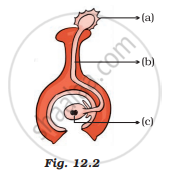Advertisements
Advertisements
Question
Draw a neat and labelled diagram.
Spore formation
Solution

APPEARS IN
RELATED QUESTIONS
For binary fission, Amoeba required .................... parent cells.
(a) Three
(b) Two
(c) One
(d) Zero
Yeast reproduces by _________.
(a) spore formation
(b) multiple fission
(c) fragmentation
(d) budding
What is multiple fission?
Name the following : 'Blobs' that develop at the tips of the non-reproductive threads in Rhizopus.
Explain the process of regeneration in Planaria.
List any two modes of asexual reproduction in animals.Under which mode of reproduction is vegetative propagation placed and why?
List two advantages of vegetative propagation.
Binary fission is a method of asexual reproduction.
What is metamorphosis?
State two disadvantages of vegetative propagation?
Draw in sequence (showing the four stages), the process of binary fission in Amoeba.
Explain why, more complex multicellular organisms cannot give rise to new organisms through regeneration.
Why do green grass plants spring up in dry fields on their own after the rains?
How does an Amoeba reproduce? Describe the process of reproduction in Amoeba with the help of labelled diagrams of different stages in its reproduction process.
What is meant by multiple fission? Name one organism which reproduces by the process of multiple fission.
What is tissue culture?
What is a 'cutting' in respect of plants for propagation purposes?
What care should be taken while making a cutting from a plant?
The two organisms which can regenerate fully from their cut body parts are :
(a) Paramecium and Hydra
(b) Hydra and Amoeba
(c) Planaria and Leishmania
(d) Hydra and Planaria
The stem of a fruit tree X fixed in soil is cut in a slanting way. The upper part of stem of another fruit tree Y of different variety of same species is also cut in a slanting way. The cut stem of tree Y, without roots but having some leaves, is placed over the rooted cut stem of tree X in such a way that their cut surfaces fit together properly. While joining the two cut stems, care is taken to make sure that the layer Z of one cut stem is in contact with layer Z of the other cut stem. The joint of cut stem is bound tightly with a piece of cloth and covered properly with polythene. Soon the cut heals and the two stems grow together and become one fruit tree producing leaves, flowers and fruits.
(a) What is the name of this method of producing plants or trees?
(b) What name is given to the cut stem of tree X having roots?
(c) What name is given to the cut stem of tree Y which has no roots but has some leaves?
(d) Name the layer Z.
(e) Why should the layer Z of one cut stem be in contact with the layer Z of the other cut stem?
(f) Name any four fruit trees which are usually bred by this technique.
(g) State any one advantage of producing fruit trees by this technique.
Fill in the blank:
Budding produces cells of __________ size.
Mention the common method of reproduction in Yeast.
What happens when on maturation sporangia burst?
In which of the following figures is budding not shown?
(A) I
(B) II
(C) III
(D) IV
What is regeneration in organism?
A student was given two permanent slides, one of binary fission in Amoeba and other of budding in yeast. He was asked to identify any one difference in the nucleus of the two. One such difference, he identified correctly was
(1) Presence of one nucleus in Amoeba, two in yeast cell and one in bud.
(2) Presence of two nuclei in centrally constricted Amoeba, one in yeast cell and one in its bud.
(3) Presence of two distant nuclei in Amoeba, one in yeast cell and two in bud.
(4) Presence of a single nucleus each in Amoeba, yeast cell and its attached bud.
Write the correct option from the given multiple options.
Vegetative propagation is performed with the help of ..........................in sweet potato.
a) root
b) stem
c) leaf
d) flower.
Define vegetative propagation. List its two methods.
Give the name of the plant that reproduces vegetatively by: Stem-cutting
How is micropropagation carried out?
What is protandry?
Write a note on different types of endosperms in angiosperms.
Define.
Fragmentation
Identify the type of reproduction from the following explanation and draw a neat and labelled diagram.
- The body of the parent organism breaks up into many fragments and each fragment starts to live as an independent new organism.
- Give two examples of living organisms which follow this type of reproduction method.
The ability of a cell to divide into several cells during reproduction in Plasmodium is called ______
Which is the most common method of reproduction in the majority of fungi and bacteria?
In Rhizopus, tubular thread-like structures bearing sporangia at their tips are called
In the diagram given in Figure 12.2 label the parts marked (a), (b) and (c).

Which one of the following pairs is wrongly matched while the remaining three are correct?
Match the columns:
| Column A (Asexual) | Column B (Examples) | ||
| (a) | Spore formation | (1) | Spirogyra |
| (b) | Conidia formation | (2) | Yeast |
| (c) | Fragmentation | (3) | Chlamydomonas |
| (d) | Budding | (4) | Penicillium |
